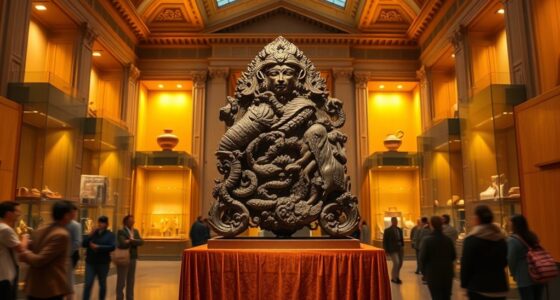To decolonize museums and bring Indigenous perspectives into art spaces, you need to recognize colonial legacies that influence collections and narratives. Build meaningful partnerships with Indigenous communities to guarantee their voices guide displays and repatriation efforts. Support Indigenous-led initiatives and showcase their knowledge authentically. Address challenges like incomplete records and cultural appropriation while promoting ethical practices. If you keep exploring, you’ll gain deeper insights into creating inclusive, respectful museum environments that honor Indigenous cultures.
Key Takeaways
- Incorporate Indigenous voices and narratives through collaborative curation and community-led exhibitions.
- Prioritize provenance research and ethical repatriation of artifacts to respect Indigenous sovereignty.
- Embed traditional knowledge and cultural practices within display designs and interpretive materials.
- Foster partnerships with Indigenous communities for ongoing dialogue, co-creation, and decision-making processes.
- Implement decolonizing frameworks that challenge colonial narratives and promote equitable representation.
Recognizing Colonial Legacies in Museum Traditions
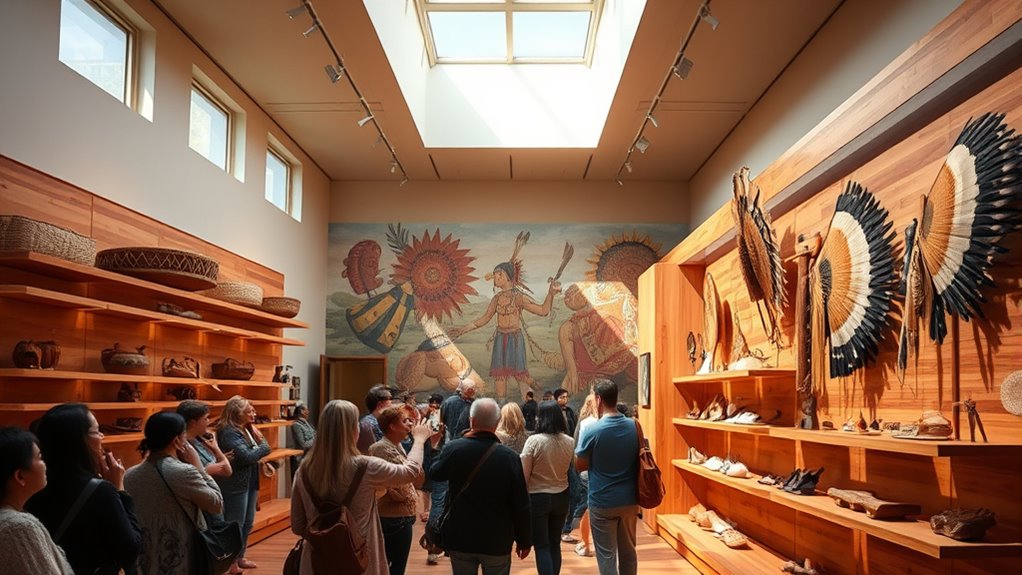
Recognizing colonial legacies in museum traditions requires understanding how many of today’s institutions originated from collections built during imperial and colonial expansions. You should realize that many significant collections were funded by wealth generated through colonial enterprises like slavery and exploitation, such as Sir Hans Sloane’s collection, which founded the British Museum. These objects were often acquired through purchase, excavation, or theft from Asia, Africa, and other colonized regions, with little regard for indigenous rights. Museums historically framed their collections as preservation efforts, assuming indigenous cultures would vanish, justifying removal. This history embedded colonial values into museum missions, shaping their displays and narratives. Recognizing these origins is essential to understanding how colonial power dynamics still influence museum practices today. Many collections include artifacts obtained unethically or without proper provenance, highlighting the ongoing need for provenance research and ethical reassessment. Additionally, decolonization efforts aim to address these injustices by reevaluating how collections are acquired, displayed, and interpreted to better honor indigenous perspectives and sovereignty. Furthermore, understanding the legacy of colonialism is vital for developing more equitable museum policies and practices. To truly decolonize museum practices, it is also important to consider ethical collection methods and how they can be improved to prevent future injustices. Moreover, applying ethical collection practices can help restore trust and respect with indigenous communities. Recognizing the importance of repatriation is a key step toward rectifying historical wrongs and honoring indigenous rights.
Building Partnerships With Indigenous Communities
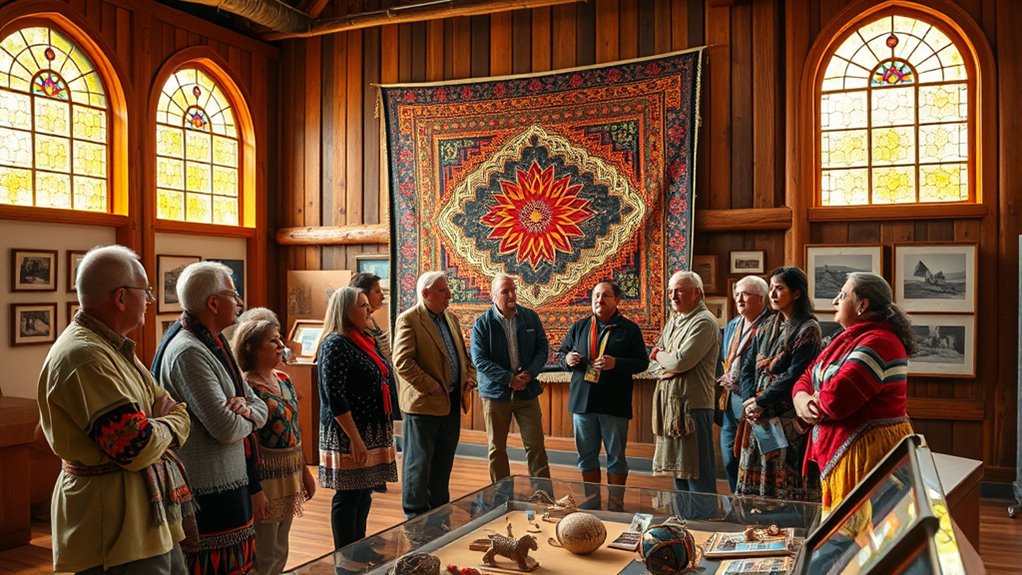
Building meaningful partnerships with Indigenous communities requires intentional effort and mutual respect. You should prioritize community engagement models that involve elders, artists, and museum professionals working together to deepen cultural understanding and create effective programs. Recognize the expertise of community members to develop authentic initiatives, and foster cross-cultural dialogue through events like film showcases and storytelling projects. Long-term partnerships are essential, so nurture trust and sustain collaboration over time. Incorporate cultural sensitivity training for staff and support community-led initiatives to ensure respectful, impactful programs. Promote Indigenous empowerment by providing resources and leadership development opportunities. By engaging multigenerational audiences and embracing inclusive governance, you can build partnerships that honor Indigenous voices and foster genuine cultural exchange. Implementing responsible collaboration practices can further strengthen these relationships and ensure respectful, mutually beneficial outcomes. Additionally, understanding the importance of social media and online platforms can help amplify Indigenous voices and expand community engagement efforts. Fostering trust and transparency is fundamental to maintaining respectful, collaborative relationships that honor Indigenous sovereignty and cultural integrity. Incorporating cultural practices like yoga can also promote holistic well-being and mutual understanding within these collaborations. Moreover, integrating cultural knowledge into programming can enhance authenticity and deepen engagement with Indigenous communities. Embracing community-based approaches ensures that initiatives remain rooted in the values and needs of Indigenous peoples, fostering sustainable and respectful partnerships.
Reclaiming Cultural Heritage Through Repatriation
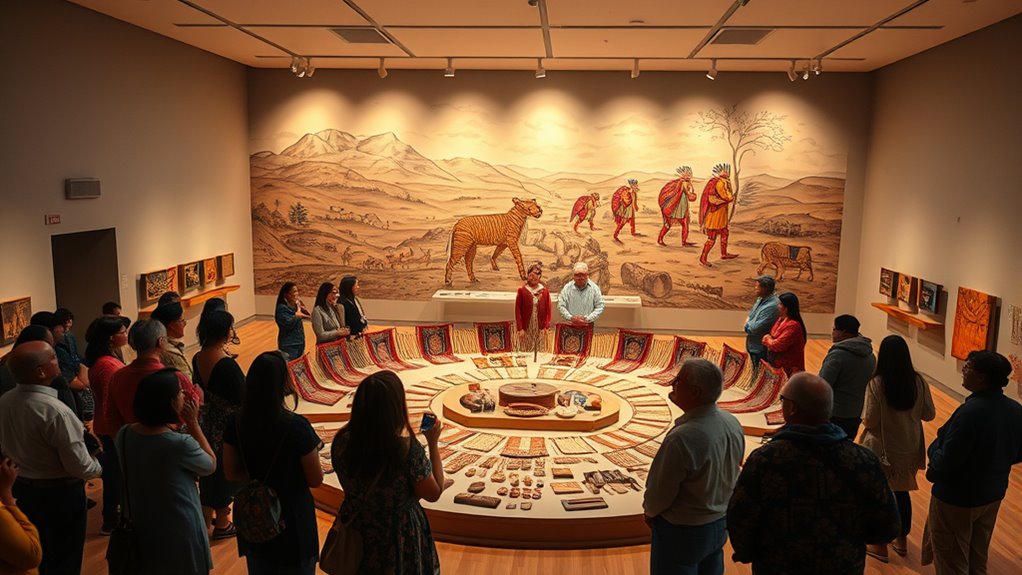
How can museums effectively reclaim cultural heritage, given the complex legal and ethical landscape? You must navigate laws like NAGPRA, which mandates inventory and return of Native American remains and objects. Despite progress, many institutions resist swift repatriation due to limited resources and bureaucratic delays. Some museums label remains as “culturally unidentifiable,” complicating efforts. To make meaningful change, you need to:
- Prioritize tribal consultation and respect Indigenous sovereignty
- Secure dedicated funding and staffing for repatriation processes
- Develop clear protocols for identifying and returning contested remains which are often difficult to establish due to incomplete or vague records. Additionally, understanding the cultural context of artifacts can aid in more accurate identification and respectful repatriation efforts. Incorporating indigenous knowledge systems into interpretive frameworks can further enhance the authenticity and sensitivity of the process, as technological advancements like AI in Education could support documentation and community engagement. Recognizing the importance of natural materials used in Indigenous artifacts—such as wood, textiles, and organic pigments—can also help in authentic identification and respectful handling during repatriation. Engaging with community-led research can provide authentic cultural insights, facilitating more respectful and accurate repatriation.
Empowering Indigenous-Led Cultural Institutions
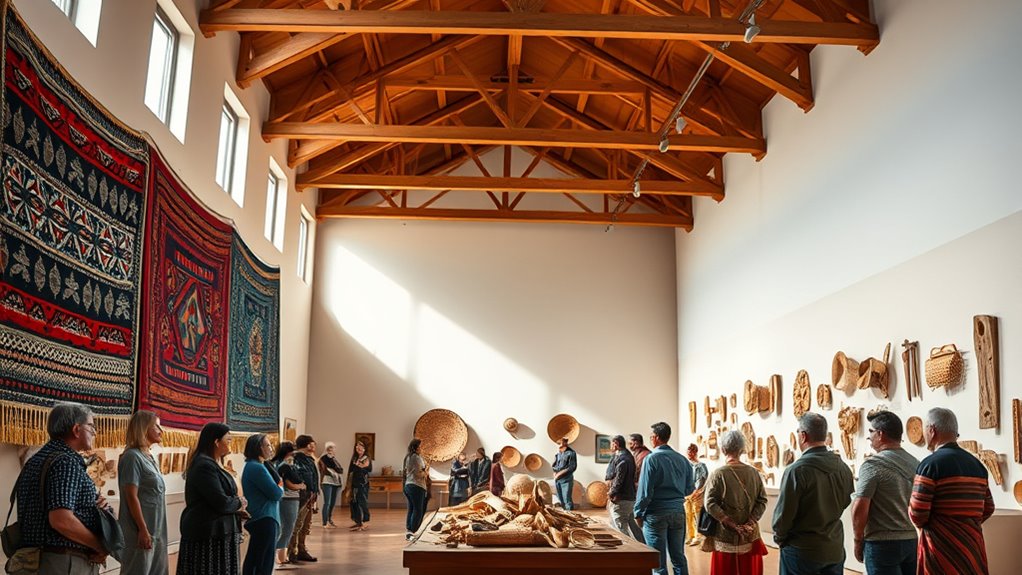
Empowering Indigenous-led cultural institutions is essential for amplifying Native voices and ensuring that Indigenous communities control their cultural narratives. These institutions prioritize community-driven projects and educational programs that reflect Indigenous perspectives, fostering cultural relevance and sensitivity. They actively engage with local communities to share traditional practices and knowledge, strengthening cultural ties. Funding from organizations like the First Peoples’ Cultural Council supports language preservation and cultural revitalization efforts. Collaborations with educational institutions help embed Indigenous perspectives into mainstream education, benefiting future generations. By promoting Indigenous leadership and supporting community initiatives, these institutions enable cultural healing and continuity. Their work guarantees that Indigenous voices are heard, respected, and centered in the storytelling and preservation of their rich cultural heritage. Building resilience and empathy within these institutions promotes a deeper understanding of Indigenous histories and experiences, fostering respectful and meaningful connections. Incorporating cultural competency training ensures that staff and visitors alike approach Indigenous narratives with sensitivity and understanding. Additionally, ongoing AI security measures are crucial to safeguard digital cultural resources and prevent misappropriation or misuse. Recognizing the importance of self-watering plant pots in sustainable gardening exemplifies how community practices can be supported through innovative solutions, paralleling efforts to preserve Indigenous knowledge systems. Moreover, integrating traditional ecological knowledge into museum exhibits can enrich visitors’ understanding of Indigenous relationships with the environment.
Showcasing Indigenous Knowledge and Perspectives
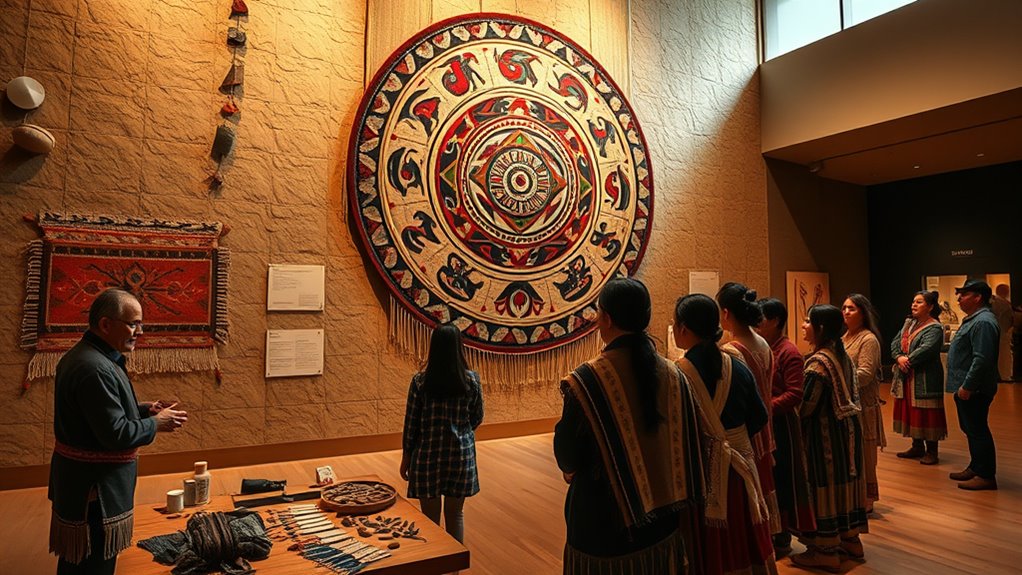
Have you ever considered how museums can serve as platforms for authentic Indigenous voices? They do this by showcasing Indigenous knowledge alongside Western science, fostering mutual understanding. Collaborative exhibitions, like *Roots of Wisdom*, involve Indigenous communities directly, ensuring genuine representation. These exhibits blend traditional knowledge with contemporary art, illustrating cultural continuity and evolution. The exhibit highlights stories from four native communities, emphasizing indigenous practices and resilience. Museums partner with Indigenous groups, supporting co-created displays that reflect authentic perspectives. Exhibitions feature Indigenous worldviews, emphasizing land, sovereignty, and social issues. Public programs incorporate workshops and community events to deepen engagement with Indigenous ecological practices, enriching visitors’ understanding of Indigenous knowledge systems. Recognizing the importance of emotional support can further enhance the healing and empowerment of Indigenous communities through respectful representation.
Navigating Challenges and Embracing Future Change
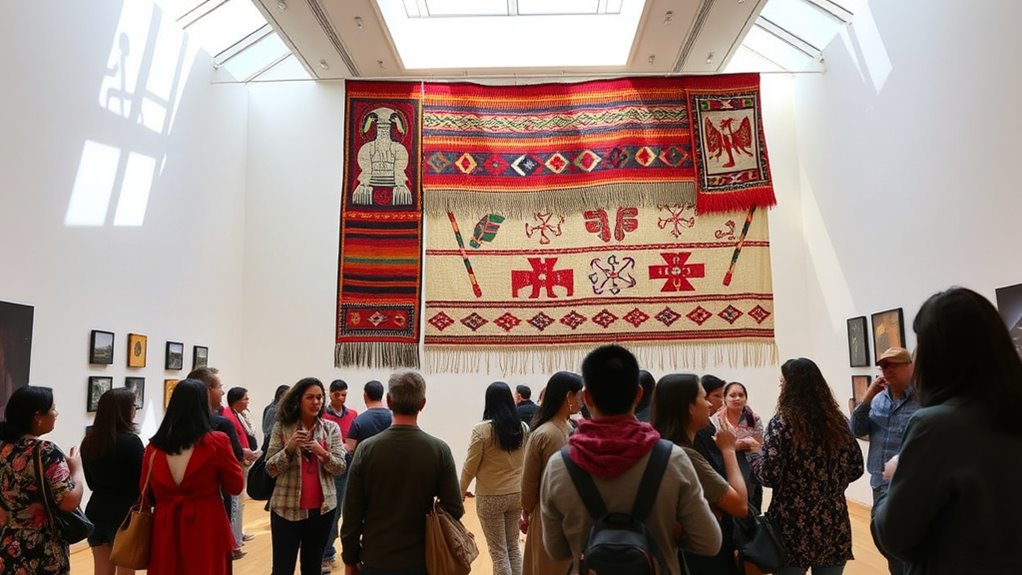
Museums face significant structural challenges that can impede efforts to decolonize and incorporate Indigenous perspectives. Many are built on non-Indigenous systems of authority, making change difficult. High costs limit access, reinforcing perceptions of exclusivity. Traditional narratives often center on Eurocentric views, which are hard to dismantle. Cultural appropriation can happen unintentionally when Indigenous knowledge and labor are used without real collaboration. Repatriation debates, like those over the Benin Bronzes, highlight these tensions. To move forward, you need to revise exhibit labels and wall texts, challenging dominant stories that marginalize Indigenous cultures. Engaging Indigenous communities and providing cultural sensitivity training are essential steps. Embracing digital platforms, collaborative exhibitions, and institutional reforms can help you foster more inclusive, respectful, and future-ready museums.
Frequently Asked Questions
How Can Museums Effectively Evaluate Their Own Colonial Biases?
You can start by examining the origins of your collections to identify colonial acquisition methods. Engage with indigenous communities to gain their perspectives and guarantee respectful representation. Diversify your curatorial teams to include marginalized voices. Regularly critique your exhibition narratives to avoid reinforcing colonial stories. Implement policies like repatriation and community-led projects, and train staff on colonial history. Continuous reflection and adaptation will help you address biases effectively.
What Training Is Available for Museum Staff on Indigenous Cultural Protocols?
Imagine a museum staff trying to dance the cultural protocol waltz without a clue—awkward and out of sync. Luckily, training programs like the C2C Care Course teach you how to dance respectfully with indigenous communities. You’ll learn to create welcoming spaces, understand cultural needs, and develop collaborations guided by indigenous voices. These resources help you move confidently, avoiding missteps and showing genuine respect in every interaction.
How Do Indigenous Communities Prioritize Which Artifacts to Reclaim?
You might wonder how indigenous communities decide which artifacts to reclaim. They prioritize items based on cultural significance, especially those essential for preserving their heritage and spiritual practices. Community input plays a key role, and they focus on artifacts with deep cultural or ceremonial importance. Additionally, legal frameworks and historical context guide their choices, ensuring that the most meaningful items are returned to sustain their cultural identity and practices.
What Funding Sources Support Indigenous-Led Museum Initiatives?
Funding for Indigenous-led museum initiatives is like a lifeline, connecting communities to resources they need. You can access government programs like MAP, which covers up to 75% of project costs, or Digital Museums Canada for digital projects. Tribal councils often provide initial support, while foundations and arts organizations also fund initiatives. Combining these sources helps you prioritize and sustain your projects, empowering Indigenous voices in cultural preservation.
How Can Visitors Be Encouraged to Engage With Decolonizing Museum Practices?
You can encourage visitors to engage with decolonizing museum practices by offering interactive exhibits like decoding games and mock archaeological digs that promote active learning. Invite them to rethink traditional narratives, fostering critical reflection. Use programming that highlights Indigenous perspectives and involve community voices in curation. Train staff to facilitate meaningful conversations and create platforms for Indigenous artists. Regularly gather feedback to improve engagement and guarantee your efforts resonate, inspiring visitors to embrace decolonization.
Conclusion
By actively engaging with indigenous communities and respecting their voices, you challenge the lingering colonial legacies in museums. Embracing the theory that decolonization isn’t just about repatriation but transforming perspectives, you realize true change requires ongoing commitment. When you prioritize indigenous-led initiatives and perspectives, you help create a space where cultural heritage is honored and authentic histories are shared. This journey isn’t just about museums—it’s about fostering genuine understanding and reconciliation for future generations.



